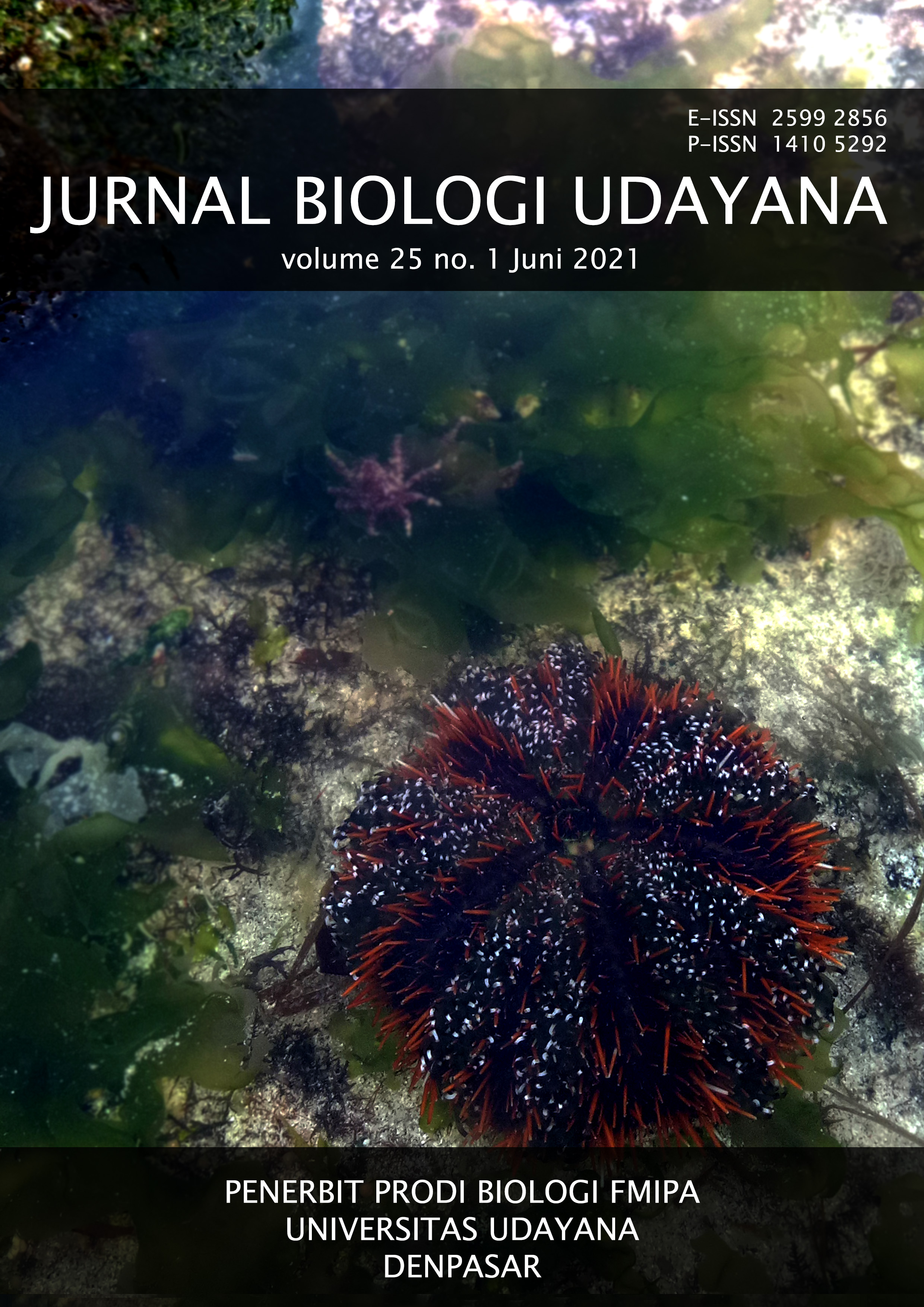Morphological and molecular characters of freshwater shrimp of Macrobrachium pilimanus species group in Opak, Winongo and Sempor Rivers, Yogyakarta
Abstract
Macrobrachium is a genus of the Crustacea subphylum with the highest diversity. Identification of the morphology of the genus Macrobrachium is mostly challenging due to the characters for species level identification are complicated, whereas many characters are common to all Macrobrachium species. In addition, it is difficult to identify morphology because of the influence of social dominance in males. Therefore, another approach is needed to identify Macrobrachium accurately, one of which is by barcoding DNA using the 16S mitochondrial gene. This study was aimed to determine the morphological and molecular characters of Macrobrachium pilimanus species group based on the 16S mitochondrial gene from the Opak, Winongo, and Sempor rivers, in Daerah Istimewa Yogyakarta. Furthermore, shrimp samples were identified based on morphological, meristic, and morphometric characters. Meanwhile, molecular analysis uses 16Sar as forward primer and 16Sbr as reverse primer. Based on the morphological identification results, the shrimp samples obtained could only be identified up to the level of the Macrobrachium genus. In addition, the shrimp samples can also be included in the Macrobrachium pilimanus species group based on the general characteristics of the species group. The shrimp samples in this study have highest similarities in character with the species M. pilimanus and M. empulipke distributed in Java. Based on molecular analysis, sample from Winongo River (WNM1) has a similarity of 87.63% with Macrobrachium forcipatum (JQ362454.1) and 87,02% with M. dienbienphuense (JQ390474.1), which means that it is a different species from the species in the GenBank. Macrobrachium forcipatum and M. dienbienphuense are members of M. pilimanus species group. The conclusion of this research is that all the samples are member of M. pilimanus species group.
Downloads
References
Cai Y, Naiyanetr P, Ng PKL. 2004. The freshwater prawns of the genus Macrobrachium Bate, 1868, of Thailand (Crustacea: Decapoda: Palaemonidae). Journal of Natural History 38(5): 581-649
Cartwright RA. 2009. Problems and Solutions for Estimating Indel Rates and Length Distributions. Molecular Biology and Evolution 26(2): 473-480
Chace FA, Bruce AJ. 1993. The Caridean shrimps (Crustacea: Decapoda) of the Albatross Philippine Expedition, 1907–1910, Part 6: Superfamily Palaemonoidea. Smithsonian Contributions to Zoology 543: 1–152
Chen RT, Tsai CF, Tzeng WN. 2009. 16S and 28S rDNA Sequences in Phylogenetic Analyses of Freshwater Prawns (Macrobrachium Bate, 1868) from Taiwan. Journal of Crustacean Biology 29(3): 400-412
Cox CB, Moore PD, Ladle R. 2016. Biogeography: An Ecological and Evolutional Approach. Ninth Edition. John Wiley & Sons, Inc., Oxford. p. 34, 106.
Fischer W, Bianchi G (eds). 1984. FAO species identification sheets for fishery purposes: Western Indian Ocean; (Fishing Area 51). Food and Agricultural Organization of the United Nations. Rome.
Fransen C, de Grave S, Ng P. 2010. Studies on Malacostraca: Lipke Bijdeley Holthuis Memorial Volume. Koninklijke Brill NV. Leiden, p. 716.
Grant WS, Bowen BW. 1998. Shallow Population Histories in Deep Evolutionary Lineages of Marine Fishes: Insights from Sardines and Anchovies and Lessons for Conservation. The American Genetic Association 89: 415-426
Guo C, McDowell IC, Nodzenski M, Scholtens DM, Allen AS, Lowe WL, Reddy TE. 2017. Transversions have Larger Regulatory Effects than Transitions. BMC Genomics 18(394): 1-9
Holthuis LB. 1952. A general revision of the Palaemonidae (Crustacea, Decapoda, Natantia) of the Americas. II. The subfamily Palaemoninae. Occasional Papers of the Allan Hancock Foundation 12: 1–396
Muphy NP, Austin CM. 2002. A Preliminary Study of 16S rRNA Sequence Variation in Australian Macrobrachium Shrimps (Palaemonidae: Decapoda) Reveals Inconsistencies in Their Current Classification. Invertebrate Systematics 16: 697-701
Nei M. 1987. Molecular Evolutionary Genetics. Columbia University Press, New York, USA.
Nei M, Roychoudhury AK. 1974. Genic variation within and between the three major races of man, Caucasoids, Negroids, and Mongoloids. The American Journal of Human Genetics, 26: 421–443.
Nei M, Li W. 1979. Mathematical Model for Studying Genetic Variation in Terms of Restriction Endonucleases. Proceedings of the National Academy of Sciences of the United States of America, 76(10): 5269–5273.
Ng PKL. 1995. Freshwater Decapod Crustaceans (Potamidae, Palaemonidae) of Temengor Forest Reserve, Hulu Perak, Malaysia. Malayan Nature Journal 48: 249-257
Ou ACT, Yeo DCJ. 1995. A New Species of Freshwater Prawn, Macrobrachium platycheles (Decapoda: Caridea: Palaemonidae) from Singapore and Peninsular Malaysia. The Raffles Bulletin of Zoology 43(2): 299-308
Pangastuti A. 2006. Definisi Spesies Prokaryota Berdasarkan Urutan Basa Gen Penyandi 16S rRNA dan Gen Penyandi Protein. Biodiveristas 7(3): 292-296
Short JW. 2004. A revision of Australian river prawns, Macrobrachium (Crustacea: Decapoda: Palaemonidae). Hydrobiologia 525: 1-100
Wowor D, Choy SC. 2001. The Freshwater Prawns of The Genus Macrobrachium BATE, 1868 (Crustacea: Decapoda: Palaemonidae) from Brunei Darussalam. The Raffles Bulletin of Zoology 49(2): 269-289
Wowor D, Cai Y, Ng PKL. 2004. Crustacea: Decapoda, Caridea. In: Yule, C.M., Sen, Y.H. (Eds.), Freshwater Invertebrates of the Malaysian Region. Academy of Sciences. Malaysia, Kuala Lumpur.
Wowor D, Muthu V, Meier R, Balke M, Cai Y, Ng PKL. 2009. Evolution of Life History Traits in Asian Freshwater Prawns of The Genus Macrobrachium (Crustacea: Decapoda: Palaemonidae) based on Multilocus Molecular Phylogenetic Analysis. Molecular Phylogenetics and Evolution 52(2): 340-350
Wowor D. 2010. Macrobrachium empulipke, a New Freshwater Prawn Species (Decapoda, Palaemonidae) from Indonesia. Dalam: CRM 014 – Fransen et al., (eds), Lipke Bijdeley Holthuis Memorial. Leiden: Koninklijke Brill NV. pp. 715-726
Yang L, Tan Z, Wang D, Xue L, Guan M, Huang T, Li R. 2014. Species identification through mitochondrial rRNA genetic analysis. Scientific Reports 4(4089): 1-11





